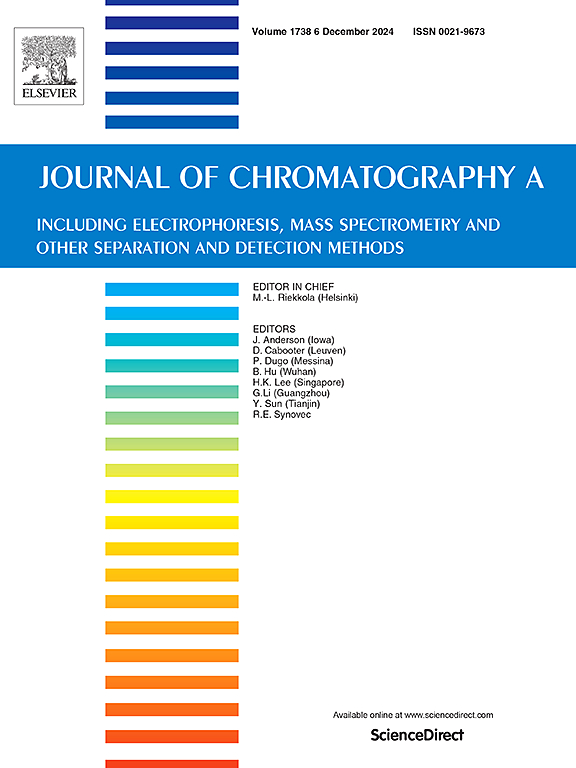Carbonyl compounds responsive 2,4-dinitrophenylhydrazine doped polydimethylsiloxane based membrane as alternative derivatizing strategy prior to in-tube solid phase microextraction coupled with capillary liquid chromatography analysis
IF 4
2区 化学
Q1 BIOCHEMICAL RESEARCH METHODS
引用次数: 0
Abstract
In this work, a DNPH doped PDMS based membrane was developed to facilitate carbonyl compound derivatization. This membrane delivers DNPH in presence of carbonyl compounds to form hydrazones. Subsequently, the resulting hydrazones are preconcentrated, separated and detected by in-tube solid phase microextraction (IT-SPME) coupled on-line with capillary liquid chromatography (CapLC) with Uv-Vis diode array detection (DAD). The method proposed allowed the determination of the analytes up to 200 µg/L. The limits of detection were between 0.1 and 3.3 µg/L and intra-day precision and inter-day precision were lower than 7 % and 21 %.
The applicability of the strategy proposed was tested in environmental (waters and PM10) and biological samples (saliva). Samples were satisfactorily analysed with recoveries in the range of 68 %-80 %. The main advantages of the proposed strategy were the increment of DNPH stability, a reduction in the solutions and wastes required for the analysis and protection of the chromatographic column minimizing the excess of DNPH, thus providing a more sustainable analytical method to estimate carbonyl compounds.
羰基化合物响应2,4-二硝基苯肼掺杂聚二甲基硅氧烷基膜作为替代衍生化策略,在管内固相微萃取耦合毛细管液相色谱分析之前。
在这项工作中,开发了一种掺杂 DNPH 的 PDMS 膜,以促进羰基化合物衍生化。这种膜在羰基化合物存在的情况下输送 DNPH,形成肼。随后,通过管内固相微萃取(IT-SPME)与带有紫外-可见二极管阵列检测(DAD)的毛细管液相色谱(CapLC)联机,对生成的酰肼进行预浓缩、分离和检测。所提出的方法可测定高达 200 µg/L 的分析物。检测限为 0.1 至 3.3 µg/L,日内精密度和日间精密度分别低于 7 % 和 21 %。在环境样本(水和 PM10)和生物样本(唾液)中测试了所建议策略的适用性。样品的分析结果令人满意,回收率在 68%-80% 之间。所提策略的主要优点是提高了 DNPH 的稳定性,减少了分析所需的溶液和废物,保护了色谱柱,最大限度地减少了 DNPH 的过量,从而提供了一种更可持续的羰基化合物估算分析方法。
本文章由计算机程序翻译,如有差异,请以英文原文为准。
求助全文
约1分钟内获得全文
求助全文
来源期刊

Journal of Chromatography A
化学-分析化学
CiteScore
7.90
自引率
14.60%
发文量
742
审稿时长
45 days
期刊介绍:
The Journal of Chromatography A provides a forum for the publication of original research and critical reviews on all aspects of fundamental and applied separation science. The scope of the journal includes chromatography and related techniques, electromigration techniques (e.g. electrophoresis, electrochromatography), hyphenated and other multi-dimensional techniques, sample preparation, and detection methods such as mass spectrometry. Contributions consist mainly of research papers dealing with the theory of separation methods, instrumental developments and analytical and preparative applications of general interest.
 求助内容:
求助内容: 应助结果提醒方式:
应助结果提醒方式:


